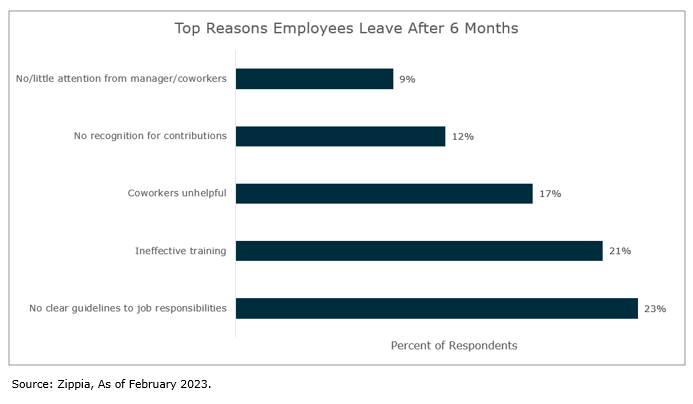Imagine a new employee starting their first day with their new company, either in-office or remote. They receive a lot of emails and a half-hearted introduction. After sitting at their desk for hours with no direction, a former co-worker texts them to ask how it’s going. Do you think they’ll have something positive to say?
Unfortunately, this is a common scenario. Employees point to a negative early experience as a major cause of their decision to leave a job early. About a third of all new employees leave before 90 days on the job.1 Onboarding is a critical time for new employees. They’re not only getting up to speed on processes and procedures, they’re also forming opinions about the company they’ve joined. Will they have access to talent development programs and opportunities to grow? Will they connect with the mission and purpose of the organization? If they don’t feel guided and supported from day one, chances are they will leave rapidly. And leaders will need to start all over to fill the position.
The Hidden Problem: New Employee Onboarding That Lacks Measurement and Recognition
Turnover caused by bad onboarding is becoming a major expense for the business world, almost doubling over the past decade. In 2023, voluntary employee turnover cost U.S. business organizations $800 billion.2
Employees feel an onboarding experience is negative when it’s incomplete, outdated, or purely focused on process. In addition, an isolating onboarding experience leads them to consider leaving the company earlier than expected. A sense of belonging is key to retention and onboarding is the best time to make new hires feel connected to a company’s objectives. Another mistake is limiting the onboarding to a few days or weeks – it may take as long as a year for a new employee to feel included and adequately trained.
Many of these problems could be solved with a good onboarding program. Consider these insights:

The solution: Inform, guide, measure, and recognize new hires
From day one, new hires should know they are a valued part of the team and are supported as they acclimate to their role. But it goes beyond a warm welcome – new employees are anxious to learn, integrate, and achieve. Remember that they want to demonstrate their abilities and bring value to the business as soon as possible. Here’s what a mutually beneficial onboarding looks like:
- Make it a defined program. Be intentional in what new employees will experience 30, 60, or 90 days in. Include expectations and priorities – what Key Performance Indicators (KPIs) they’ll be measured on, how they can track their own progress or measure their learning, and where to get extra support on challenging concepts. Make it clear that onboarding is a priority and part of their job performance. New hires should understand milestones and feel productive right from the start.
- Include leaders. 1:1 meetings with managers, mentors, and executives can help uncover goals, priorities, challenges, and other key areas for each business or team. This enables better collaboration with colleagues and clients as they complete each phase of the onboarding.
- Make it part of your culture. Ensure that the company culture is clearly demonstrated – and reinforced – by communicating company performance and growth initiatives regularly. Find ways to build community and rapport, such as team lunches, Zoom happy hours for remote employees, or gifts for workers across locations.
- Emphasize accountability. Part of employee onboarding is making expectations clear. Communicate what’s required, tools or systems they’ll need to work with, and who will confirm milestones or onboarding KPIs are achieved. Finally, demonstrate when new hires are expected to perform tasks for their roles with little or no supervision.
- Add consistent recognition. A certificate, congratulations lunch, or just a callout at a staff meeting are all good ways to recognize completion of onboarding milestones. Acknowledgement shouldn’t come just from leaders, include peers, direct reports, and even clients. Ask what your new hire would prefer – do they like coffee or trinkets, would they prefer public or private recognition, etc.
- Don’t limit recognition to job performance. It’s natural to congratulate employees for achieving KPIs but add in congratulations for more general milestones. Celebrate their first six months on the job or first solo client meeting to help keep your team engaged and progressing.
- Personalize support. Hold regular check-ins to ask about the training experience and offer feedback on performance. If a new hire is struggling, spend time with your employee to answer questions, offer insights, or clear up confusion. When the manager takes an active role in onboarding, employees are 3.4 times as likely to feel like their onboarding process was successful.3
Remember that onboarding goes beyond the first day, or even the first week. Make consistent growth and skill-building a priority for the long-term. Companies that focus on employee development and engagement create a sense of belonging that other employers just can’t beat.
The Results: Benefits of a Strong Onboarding Problem
The difference between good and bad employee retention can be measured on the productivity of tenured employees. On the flip side, employers who do new employee onboarding well experience a 56% increase in job performance, 50% drop in turnover risk, and 75% fewer sick days.4 Looking at new employees exclusively, Glassdoor reports that a strong onboarding process improves retention by 82%.5 Plus, a positive onboarding experience perpetuates outside your company walls, leading to employee referrals, better service for clients, and stronger company culture. Onboarding has a trickle-down effect – creating strong mentors and informal leaders. Top performers stay when their development is prioritized; 69% of employees will stay with a company for at least three years if their onboarding was positive.6
Now, take a look at your onboarding – how might new hires feel about the experience? Giving them manuals or setting up tech should be table stakes, go beyond those tasks to create opportunities to learn their job and integrate into their team and organization. An employee who just took a new job may have walked away from bonuses, favorite clients, or friendly colleagues. If the onboarding is welcoming, inclusive, and productive, they won’t regret it.
Need more solutions? Browse strategic planning, M&A advisory services, and other business planning services today.
Talent Institute – Register Today!
Chicago: June 4-6, 2024 | Chicago: November 19-21, 2024
Unlock the full potential of your workforce so they can realize remarkable business results at MarshBerry’s Talent Institute. This immersive workshop equips leaders with strategies and tools needed to build a thriving workforce ecosystem that goes beyond recruitment and encompasses the entire employee lifecycle. Upon the completion of Talent Institute they will earn four professional development credits toward SHRM recertification. Register today!
